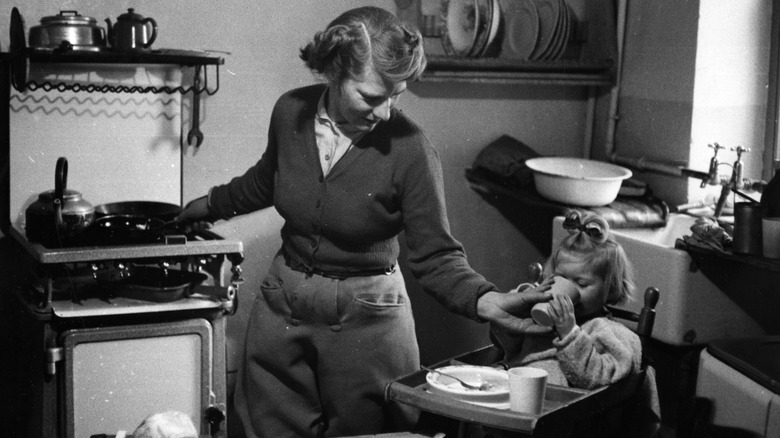
Bert Hardy/Getty Images
The favorite recipes from any era don’t just tell us about diners’ tastes at the time. They also reveal tantalizing hints about the world these diners lived in. Future anthropologists looking back at the 2020s obsession with açai bowls, matcha-flavored-everything, and Dubai chocolate will recognize in these items our obsession with antioxidants, our easy access to global ingredients, and even our susceptibility to internet hype.
If your grandmother came of age in the 1950s or 1960s, she may have told you about — or even served you — dishes that seem a bit strange and stodgy by today’s standards, such as casseroles bound with canned soup and unusual uses of “exotic” ingredients such as water chestnuts. No, Grandma wasn’t odd. She was a product of her time: During the postwar era, homemakers embraced the convenience of prepared foods, such as canned foods and mixes, and soldiers returning to the States from their service overseas brought home a new familiarity with Asian and European ingredients. While plenty of dishes from that era were forgettable (if not downright awful), many deserve a place on modern tables. Now, just as in Grandma’s day, they’re convenient and easy to make on busy weeknights, and comforting to eat.
1. Pineapple upside-down cake

MShev/Shutterstock
A classic mid-century dessert that few modern diners would turn down, pineapple upside-down cake is a treat many of us remember from our childhood. It’s a buttery yellow cake topped with sunny rings of glazed canned pineapple, each of which holds a bright maraschino cherry in its center. It’s not only drop-dead gorgeous, but tasty — the tangy, juicy pineapple and sweet cherries are a perfect foil for the rich cake. Even better, it’s fast and easy to make, yet another reason it was on regular rotation in many households.
The cake gets its name from the unusual way it’s baked. The pineapple rings and cherries are arranged on the bottom of the baking pan (along with brown sugar and butter, which will bake into a glaze), then the batter is poured on top. Once the cake is baked, the cook inverts it onto a serving plate so the pineapple rings appear on top. Upside-down cakes — once called skillet cakes, since they were historically cooked in stovetop skillets — date back to the Middle Ages. But pineapple upside-down cake only appeared with the emergence of canned pineapple (and those perfect pineapple rings) in the 1920s. While it was originally seen as an elegant and exotic treat, by the middle of the century, canned pineapple was widely available, making pineapple upside-down cake an everyday pleasure.
2. Ambrosia
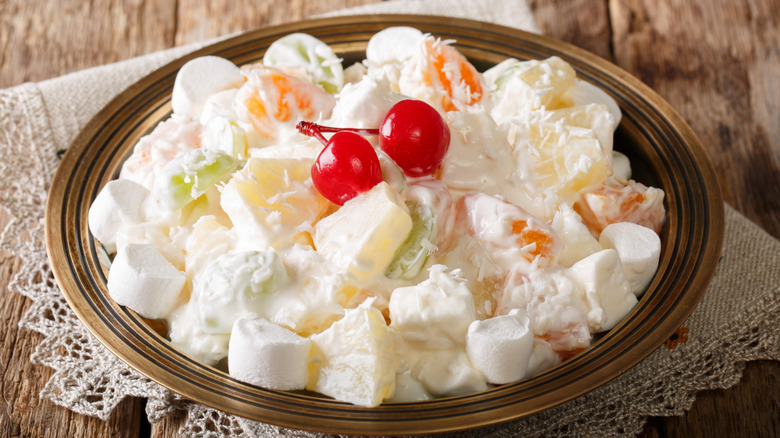
Alleko/Getty Images
A retro favorite that still makes regular appearances on some families’ tables, ambrosia is a fruit salad on steroids. Early versions were simple, like an 1867 recipe that called for nothing more than fresh grated coconut, sugar, and chopped oranges. Other versions from that era suggested fresh pineapple in place of oranges. Over time, like a dust bunny, it picked up other ingredients, which, depending on the cook, could include cherries, pecans, peaches, marshmallows, bananas, whipped cream, or even pudding mix. In short, it evolved from a delicacy featuring once-rare fresh ingredients, like coconut, to a middle-class standby (once these ingredients became commonplace) to a kitschy punchline.
Nevertheless, it’s a dish that cooks from older generations remember fondly and still enjoy making regularly for their friends and family. Among these is James Beard award-winning cookbook writer Nathalie Dupree. In her 80s, as of this writing, she fondly remembers chopping up oranges for her family’s holiday ambrosia as a child. She likes it best closest to its original form — no marshmallows or creamy dressing, please. But if you want the guilty pleasure of a fruit salad you can enjoy like a dessert, try this version of traditional ambrosia with a creamy yogurt and whipped topping dressing, garnished with marshmallows and cherries.
3. Pot roast
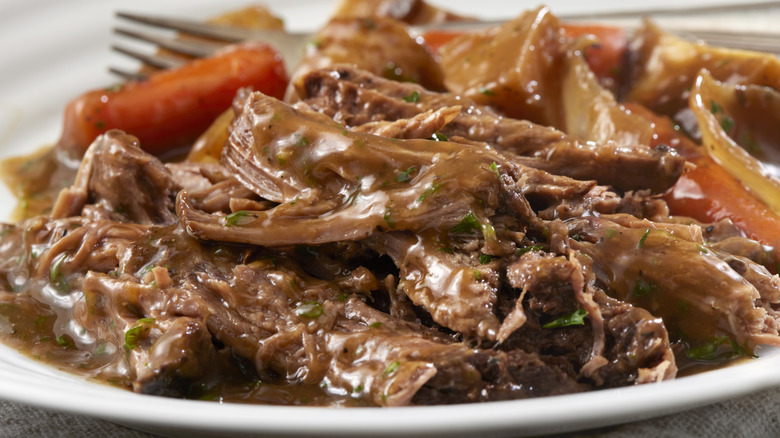
Lauripatterson/Getty Images
Being a housewife in the 1950s and 1960s wasn’t fun. As Betty Friedan noted in her classic book “The Feminine Mystique,” women were expected to handle everything related to family and the home, from cooking to cleaning to sewing clothes to driving kids to and from school, themselves. They often saw no one outside their immediate families during the day, and even if they had the ambition to pursue a career, full-time motherhood was the only socially acceptable option. Even more galling, women were expected to enjoy every minute of this. They didn’t — as evidenced by the fact that a best-selling cookbook of the era was titled, “The I Hate to Cook Book.”
Time-strapped mid-century housewives were delighted to see a book of recipes by an author in the same predicament they were, being too busy or uninspired to cook, but still needing to produce hot meals acceptable to their families night after night. A favorite solution for them was pot roast, made with an inexpensive cut of beef, slow-braised with a short list of ingredients (which often included instant soup mix). You could throw it together and put it in the oven mid-afternoon, go about your business, and sit down to a satisfying meal a few hours later. With the popularity of slow cookers, modern cooks have rediscovered the convenience of pot roast — the ever-popular Mississippi roast is a modern reboot your grandmother would heartily approve of.
4. Salisbury steak
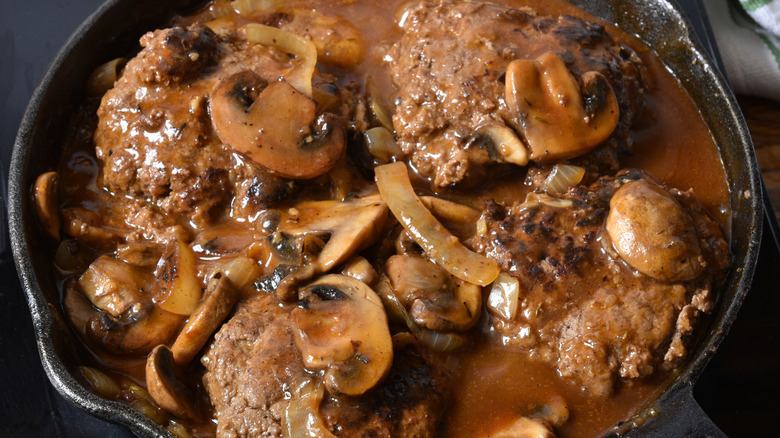
Msphotographic/Getty Images
Salisbury steak is one of those dishes that sounds fancier than it actually is, and depending on who’s making it and the quality of their ingredients, it can be a dignified and satisfying meal. It’s basically large, seasoned hamburger patties napped in brown gravy, but the very simplicity of the dish made it ripe for abuse — the fact that the meat could be endlessly extended with filler and disguised with gravy made it a favorite in military kitchens and school cafeterias, as well as a standby in mid-century frozen dinners. More wholesome and flavorful versions were also popular among home cooks. Your grandmother likely used a simple Salisbury steak recipe like this one, flavored with mushrooms, onions, and a dash of Worcestershire sauce.
Salisbury steak’s reputation as junk food in disguise would have come as an ugly surprise to its inventor, Civil War-era physician James Henry Salisbury. He strongly believed that good diet was the key to health, and his idea of healthy food was minced beef — fresh fruits and vegetables, he advised, were to be avoided. He developed his eponymous beef patties to restore sick soldiers by providing “the maximum of nourishment with the minimum of effort to the digestive organs” (via Smithsonian magazine). We should be grateful, too, that someone decided to name the dish after Salisbury rather than maintain Salisbury’s original name for his creation, “muscle pulp of beef.”
5. Chicken à la King
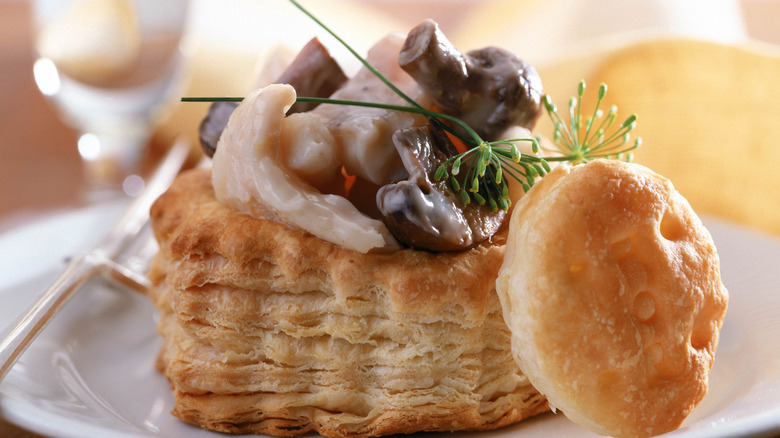
Brian Hagiwara/Getty Images
Rarely seen on modern tables, chicken à la King was once a ubiquitous dish in restaurants and at ladies’ luncheons — it appears on over 300 menus from the 1910s to the 1960s in the archives of the New York Public Library. It’s basically diced, cooked chicken, mushrooms, and pimientos in a creamy sauce (often enlivened with a bit of sherry) served over toast, and during its heyday, it was welcomed as fancy comfort food. For mid-century cooks, chicken à la King had it all. It was elegant and vaguely French, but easy to make with everyday ingredients. Some cooks elevated it further by serving it in a puff pastry shell, like a vol-au-vent, rather than on toast or flavoring it with curry powder. If your grandmother didn’t have a chicken à la King recipe among her regular ladies’ luncheon items, she almost certainly had friends who did.
Despite its Frenchified name, chicken à la King is an all-American creation. According to one story, the dish was invented in the early 1900s by the head chef of the Brighton Beach Hotel in New York, and named for the hotel’s owner, E. Clark King II. According to this account (first published in a brochure from the hotel), King and his wife enjoyed the dish enough to ask for seconds, which inspired the chef to put it on the menu for the hotel’s guests. The rest, as they say, is history.
6. Chicken Tetrazzini
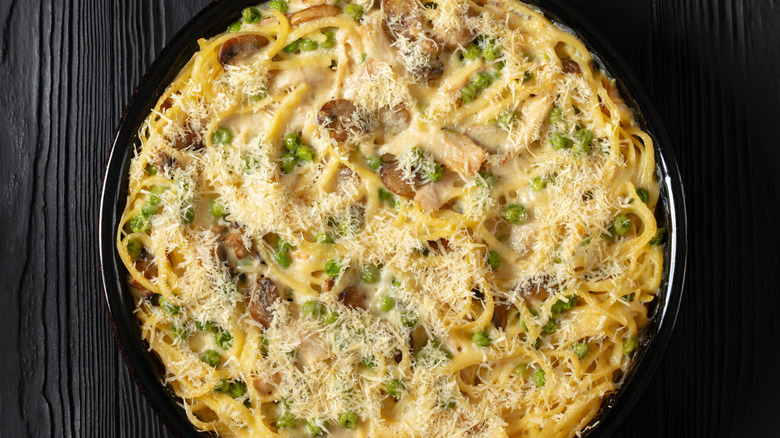
From_my_point_of_view/Getty Images
Chicken Tetrazzini, like ambrosia and chicken a la King, started out as elegant, high-class food and evolved into a middle-class favorite before falling out of fashion and into obscurity. But this old-school dish of spaghetti and shredded chicken, baked in a creamy sauce and topped with cheese, can still be a hearty and comforting meal and a crowd-pleasing potluck dish, if made with care — later versions made with canned cream of mushroom soup and other convenience foods likely contributed to its modern reputation as heavy and unsophisticated.
Despite the name (and the presence of spaghetti), chicken Tetrazzini has no roots in Italian cuisine. Instead, it was an early 20th-century American invention, developed in either New York or San Francisco, to honor Italian opera star Luisa Tetrazzini. The earliest versions were flavored with mushrooms and Parmesan, and topped with two classic French sauces, chicken velouté and hollandaise. By the middle of the 20th century, home cooks had adopted it as a weeknight staple and pared it down, swapping the two fancy sauces for a simple cream sauce, and using it as a convenient and tasty way to stretch out a little leftover chicken or turkey. Even this simplified version, however, can be a simple dining pleasure — try this chicken Tetrazzini recipe for a tasty blast from the past.
7. Rumaki
In the 1950s and 60s, tiki bars and restaurants were all the rage. Diners loved immersing themselves in environments filled with faux Polynesian décor while sipping seriously boozy cocktails like mai tais and nibbling on foods inspired by East Asia, including egg rolls and grilled chicken teriyaki skewers. Among the favorite items that appeared on menus at tiki restaurants was rumaki, a skewer of chicken liver and a chunk of water chestnut wrapped in bacon and often served with a sweet glaze. Like everything else about mid-century tiki culture, it had little connection to the actual cuisine or culture of the Pacific Islands. Instead, it was invented by restaurateur Victor Bergeron, founder of the Trader Vic’s chain of tiki restaurants.
Home cooks took to the tiki trend as well. Carved wooden serving platters and trays with tropical motifs were sought after by fashionable party hosts, who used them to serve up their homemade assortments of tiki snacks, and rumaki made frequent appearances on these platters. Cooks loved it because it’s easy to make — just wrap half a strip of bacon around a chicken liver and a piece of water chestnut, secure everything together with a toothpick, and broil until the bacon sizzles and crisps. Eaters loved it because it seems unfamiliar, despite being made with everyday ingredients, and the mixture of creamy, chewy, and crunchy textures with a pinch of salt and smoke make for a timelessly craveable combo.
8. Tuna casserole
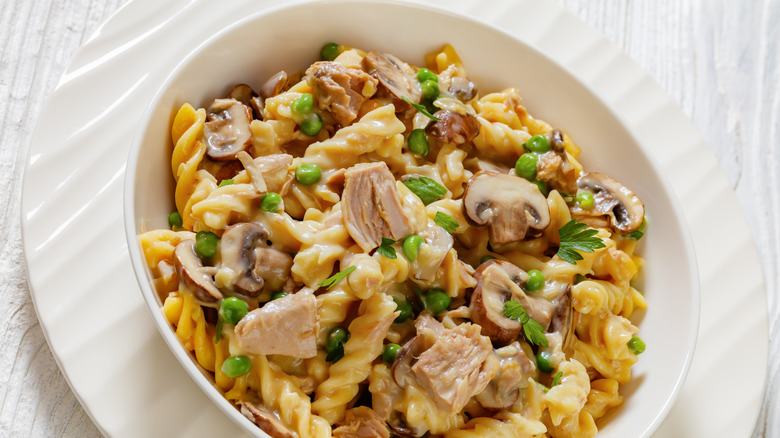
from my point of view/Shutterstock
People of a certain age — including, perhaps, your grandmother — can recall an era when popular recipes frequently included canned cream of mushroom soup, which served as a convenient substitute for homemade gravy or white sauce. This wasn’t by accident. When Campbell’s introduced its cream of mushroom soup in 1934, the company marketed it as both a soup and a sauce, and later even had its home economics staff develop recipes incorporating the soup. The ever-popular green bean casserole, topped with crispy onions, was a product of this campaign, and another was tuna casserole.
While green bean casserole has never gone away, tuna casserole, as most American cooks know it (tuna and cooked noodles bound in cream of mushroom soup and baked), has fallen out of fashion. Originally developed by Campbell’s in the 1940s, tuna casserole reached peak popularity in the 1950s. It was cheap and easy to make, and tasty by the standards of the time, especially when topped with a crispy layer of crushed potato chips. The original recipe still appears on Campbell’s website, which proclaims it to be “the original dump and bake dinner.” But let’s get real, canned cream of mushroom soup is pretty boring, as is the original recipe. For a livelier, modernized tuna noodle casserole, without goopy canned soup, use fresh mushrooms and put together your own quick sauce from scratch.
9. Jello salads
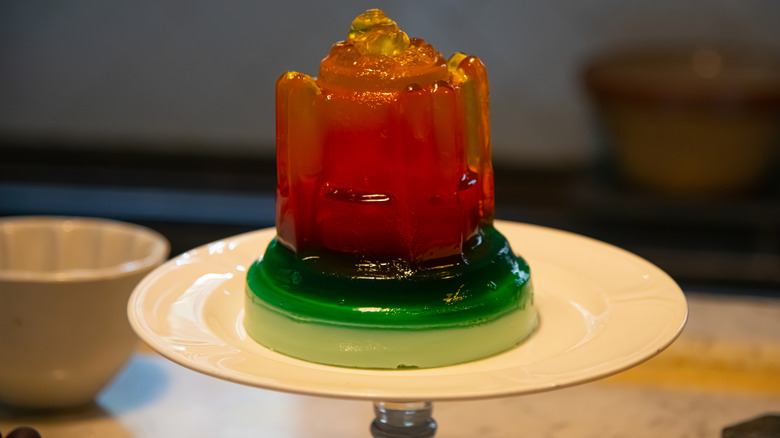
Alison Taylor Photograpy/Getty Images
In the 1950s, convenience foods were king. Manufacturers encouraged housewives to save time and effort by using shortcut ingredients, like canned vegetables and cake mixes, and they were happy to comply. It was during this era that jello reached peak popularity. But home cooks didn’t just prepare simple batches of plain jello — they went crazy with it, creating both sweet and savory molded salads. Savory Jello salads became such a thing that, for a while, the Jell-O company manufactured savory flavors such as celery and Italian dressing.
Jello salads reigned during this era for several reasons, and one was ease and convenience. All you had to do was add boiling water and optional other ingredients and wait. Molded Jello can also be quite pretty, and many mid-century cooks and diners held onto the early 20th-century sentiment that molded gelatin dishes were the height of elegance. While many jiggly salads of the era deserve to stay in the past (unless you’re really interested in a shrimp aspic mold), modern cooks are giving jello salads another look, creating fresh versions flavored with wine, fresh fruit, and goat cheese.


Dining and Cooking